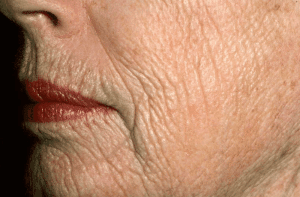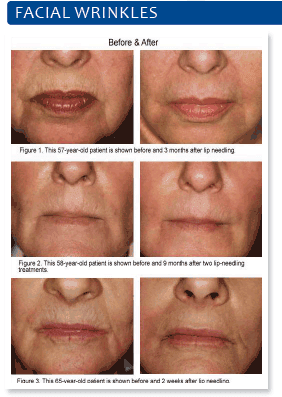Menopause and your skin
Menopause is a process that affects all women at some age; the average age is 51 years and whilst we are used to hearing about hot flushes and other symptoms very little is mentioned about how it affects the skin.
The definition of Menopause is occurring 12 months after a woman’s last menstrual period. It is the most accelerated period of ageing in a female’s life and it is the time when the most dramatic effects are seen on the skin.
It is often said that men age better than women and I personally believe this is because of the accelerate factor of the menopause.
What happens to your skin at Menopause?
Hormonal changes that occur during and after menopause change the skin in many different ways. The decline of B-Estradiol during menopause is one of the culprits in the accelerated ageing of the skin. This results in lowered oestrogen and progesterone production, which in turn leads to these changes.
As a woman gets closer to the menopause (perimenpausal stage), the following changes begin to occur in the skin:
Oily Skin
During menopause, as oestrogen levels decrease, testosterone (produced by the adrenal glands) is no longer masked in the woman’s body. Testosterone reveals itself by stimulating sebaceous glands, giving the appearance of oily skin (and the tendency toward adult acne in some women).
Facial Hair
Also due to the unmasking of testosterone, some women may develop facial hair, particularly in the chin area.
Sagging Skin and Wrinkles
Oestrogens stimulate fat deposits over the female body; as oestrogen levels drop during menopause, fat deposits tend to become concentrated over the abdomen and/or on the thighs and buttocks. The result is a loss of supportive fat below the skin of the face, neck, hands and arms; this allows sagging wrinkles to appear.
Elastosis
 ElastosisDuring menopause, the lowered oestrogen levels result in less production and repair of collagen and elastin in the dermis of the skin. This worsens if the skin is exposed to ultraviolet (UV) rays. UV rays are very destructive to collagen, and if we lose our repair mechanism, then we lose our skin’s resiliency. This results in elastosis and the skin appears yellow and thickened with bumps or furrowing as a result of sun damage.
ElastosisDuring menopause, the lowered oestrogen levels result in less production and repair of collagen and elastin in the dermis of the skin. This worsens if the skin is exposed to ultraviolet (UV) rays. UV rays are very destructive to collagen, and if we lose our repair mechanism, then we lose our skin’s resiliency. This results in elastosis and the skin appears yellow and thickened with bumps or furrowing as a result of sun damage.
Thinning Epidermis
Blood flow to the skin is reduced during menopause, and less nutrients and oxygen are available to the layers of the epidermis. This contributes to the thinning of the epidermis and a slower cell rejuvenation rate. Alongside this the barrier function of the epidermis is reduced, leading to water loss and dry skin.
More Prone to Sun Damage
As menopause progresses, the number of cells that produce protective Melanin reduces and skin appears lighter. Menopausal skin is, therefore, more prone to sun damage, making it even more important to protect the skin with a sunblock.
Hyperpigmentation / Age Spots
Oestrogens also regulates the amount of melanin our body produces. In areas of the skin that have been exposed to UV rays over the years, as menopause arrives, melanin synthesis increases. This can result in brown ‘age spots’ appearing on the face, hands, neck, arms and chest of many women.
Treating the Symptoms of Menopausal Skin
Whilst the menopause will visit every woman in time, we can hold back the symptoms it brings with it in a variety of ways.
The very best thing you can do is prepare for entering the premenopausal (sometimes referred to as perimenopausal) phase by having the best skin health possible. The first line of prevention, as we have mentioned in this article, is simply ensuring you use sun blocks when you are going out; the difference this makes cannot be exaggerated. Skin that is being affected by the reduction of oestrogen in the body is not well equipped to cope with UV rays and excessive skin drying conditions; it will age the skin significantly.
If this is already happening a good moisturiser such as Obagi Hydrate will help and this is the one that I use myself twice a day.
Research has shown that 85% of women who use Botox believe they look younger than their peers. This means that when they begin to enter the menopause they are already in a better place regarding wrinkles, so as the skin loses elasticity, collagen and volume, wrinkles are prevented from forming due to overactive muscles as they compensate for the loss of support they previously had.
Before and after Dermapen treatment
 Whilst the skin changes can have quite a dramatic effect over time, the effects can be managed with treatments such as Botox injections, to prevent the skin from creating wrinkles, coupled with Dermapen treatment to encourage collagen regrowth. Right are some photos that illustrate the benefits of this type of treatment. This is particularly effective around the mouth area.
Whilst the skin changes can have quite a dramatic effect over time, the effects can be managed with treatments such as Botox injections, to prevent the skin from creating wrinkles, coupled with Dermapen treatment to encourage collagen regrowth. Right are some photos that illustrate the benefits of this type of treatment. This is particularly effective around the mouth area.
Dermal Fillers, used alongside will also help to replace the volume that we lose and which is needed to give a more youthful look, Areas treated include the nasolabial folds (nose to mouth lines), vertical lip lines, oral commissures (corners of mouth) and the marionette lines. Skin boosters restore the hydro-balance of the skin and improve elasticity and tone to create a fresh and natural look.
So even during this accelerated period we can help hold back the problems that come from this all-encompassing change to the body AND if we prepare you to enter the menopause the results are even better!
